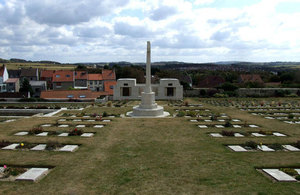Soldier saves lives, years after death
Bacteria grown from a soldier who died of dysentery in World War 1 is informing modern research into antibiotic resistance.

Cemetery
A bacteria grown from a soldier who died of dysentery in World War 1 has had its genetic code unlocked using genome sequencing. This has revealed that this bug was already resistant to penicillin around 25 years before it was commonly used to treat infectious diseases, and showed us how this important pathogen has changed over time.
A scientific paper describing this finding ‘The extant World War 1 dysentery bacillus NCTC1: a genomic analysis’ is published in today’s The Lancet as a commemoration of World War 1. This work was a collaboration between Public Health England and the Wellcome Trust Sanger Institute.
This bacteria, called NCTC1, was the very first to be submitted into the National Collection of Type Cultures (NCTC) and is a type of bacteria known as Shigella flexneri. The NCTC was started in 1920 to provide scientists with a reliable source of bacteria of known identity for their studies. It now holds over 5,000 bacteria and is housed at Public Health England (PHE) sites near London and in Porton Down in Wiltshire.
The soldier, Private Ernest Cable of the second Battalion East Surrey Regiment, died on 13 March 1915 of dysentery. Symptoms of dysentery include diarrhoea and vomiting which can be caused by the bacterium Shigella flexneri, which was isolated from Private Cable.
Bacteria constantly change (evolve) in their bid for survival. The genes which make a bacterium resistant to antibiotics are known to have existed in some cases even before the widespread use of antibiotics. The sample from Private Cable shows the genes for resistance to both penicillin and erythromycin which are both antibiotics used in medicine today. Widespread use of antibiotics is causing many more bacteria to become resistant.
As part of the analysis of the evolution of Shigella flexneri, the NCTC1 isolate was compared to 3 other Shigella flexneri strains. One known as 2457T from a Japanese patient in 1954; strain 301 taken from Beijing in 1984 and a further epidemic strain from China from 2002.
Julie Russell, Head of Culture Collections at PHE, said:
It is tragic that Private Cable died of dysentery alongside many other soldiers during World War 1 due to the terrible conditions in the trenches. Unfortunately, even 100 years later this bacteria is the cause of death of hundreds of thousands of people in developing nations each year. The root cause both now and back in the trenches in World War 1 is poor sanitation.
Bacteria are very efficient at changing to survive and Shigella bacteria have evolved to withstand antibiotic treatments. Continued efforts need to be made to improve hygiene and reduce malnutrition. Techniques like genome sequencing can help us to better understand which medicines will and won’t work by looking at bacterial genes, and may even help us develop a vaccine. Genome sequencing has revolutionised our understanding of bacteria and viruses and is already being used to help understand outbreaks of infectious disease.
When the 4 bacteria are compared side by side an evolutionary pattern can be seen,” says Dr Kate Baker, a first author from the Wellcome Trust Sanger Institute. “Genes that were absent from the 1915 strain that were present in all 3 of the later Shigella isolates we tested include genes that result in more severe disease (virulence genes) as well as even more antibiotic resistance genes.
Ends
Notes to editors
- The infection can cause severe diarrhoea and vomiting so a major part of the treatment is in the replacement of lost fluids. Today moderate or severe cases can be given antibiotics but in 1915 the care a soldier received would have been very limited.
- The bacteria (a Shigella flexneri serotype 2a) that killed Private Cable was isolated by the microbiologist Major William Broughton-Alcock of the Royal Army Medical Corps at the No. 14 Stationary hospital in Wimereux in France.
- The sample was first deposited in the NCTC by Sir Frederick William Andrewes.
- The Shigella bacteria are transmitted by the faecal-oral route and were a primary cause of diarrhoeal illness in soldiers during the First World War due to poor sanitation in the trenches and the lack of a vaccine (compared with cholera and typhoid). They continue to cause outbreaks during military campaigns even today.
- The National Collection of Type Cultures (NCTC) is the longest-established collection of human pathogenic bacteria in the world and is operated by Public Health England. www.phe-culturecollections.org.uk
- Public Health England exists to protect and improve the nation’s health and wellbeing, and reduce health inequalities. It does this through advocacy, partnerships, world-class science, knowledge and intelligence, and the delivery of specialist public health services. PHE is an operationally autonomous executive agency of the Department of Health. Website: www.gov.uk/phe. Twitter: @PHE_uk, Facebook: www.facebook.com/PublicHealthEngland
Image courtesy of British War Graves